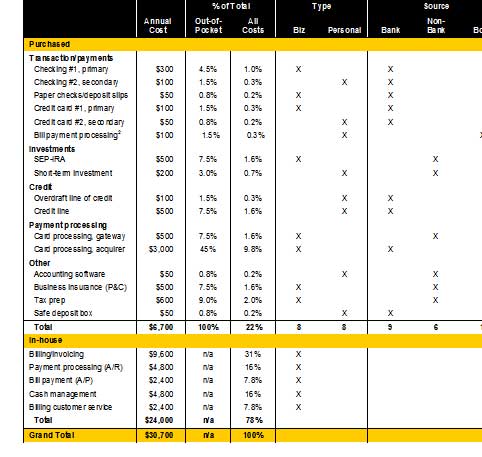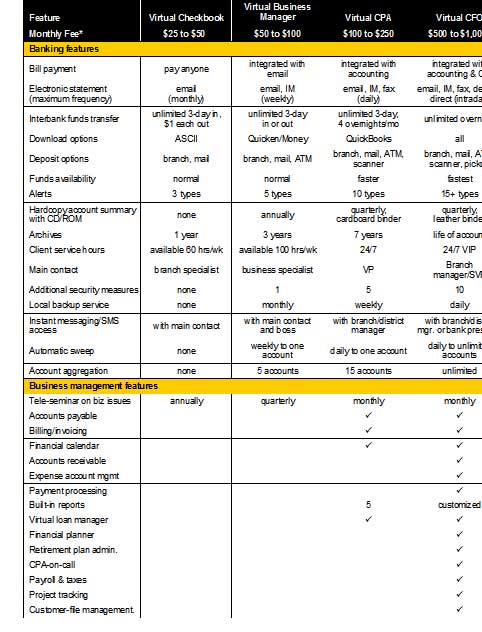Case Study: Financial product usage at one small business
Microbusinesses typically purchase a hodgepodge of
services culled from both retail and commercial banking product lines. For
example, at our own small business, we purchase 16 financial products evenly
split between consumer and business products (see Table 52, below).
Nine are sourced from banks, six are from non-banks, and one is a combined
effort. Overall, we spend $6,700 annually in fees, interest paid, and
interest foregone (for checking). But the internal costs for managing our
billings, payments, and banking, are more than three times as much, an
estimated $24,000 per year. We would gladly outsource these to a
high-quality and VERY trustworthy third party, preferably someone with a
regulatory and fiduciary responsibility to safeguard our information and
assets, like a bank.
Table 52
Financial Products & Services Used by One Small Business

Source: Online Banking Report, 6/04 1Fees and net
interest foregone (deposits) or paid (loans) assuming 2% cost of funds
2Purchased through US Bank, but processed by CheckFree and user
interface by Microsoft Money
Package accounts targeted to business segments
Most banks offer small business bundles that include checking and
other basic transaction services. However, we believe the online platform
can be used to assemble more valuable offerings targeted to small businesses
with various financial management needs. Table 53 (below) shows ways
that the small business market could be segmented. Table 54 (p 53)
outlines major feature that could be included in package accounts targeted
to the financial management needs of the small business.
Table 53
Potential Business Segments to Target
Virtual financial management packages
Most banks offer small business account bundles that include checking
and other basic transaction. We believe that there is a significant
opportunity to expand into hosted financial and customer management systems
with monthly fees of $100 or more. Following are the pros and cons of moving
into the financial management arena:
Pros
- Profitable, incremental fee income
- Publicity and image enhancement from being the first in
your market to integrate banking functionality into an overall Web-based
small business management suite - Product differentiation and an impressive unique
selling proposition - Positive word-of-mouth within the local business
community - Powerful retention tool
- Potential for licensing to other financial
institutions
Cons
- Weak/uncertain demandd: Until recently, small
businesses have been slow to adopt new banking technology. It may take
several years of marketing, sales, and training before you begin to see
a payback. - Development costss: Building a robust, highly secure
new system will be pricey; you will probably want to partner with an
accounting software developer that already has code for the basic
functionality. - Uncertain ongoing servicing costss: Being on the
bleeding edge has its risks; it will be difficult to predict ongoing
costs for system maintenance, software development, and customer
support. - Lack of employee confidence: Financial institution
front-line personnel have been known to steer clear of discussing small
business and/or online banking subjects due to uncertainty with their
operation, cost, and overall value.
Table 54
Features of Virtual Accounting Package Accounts
*Approximate monthly subscription price; additional transaction fees
would apply for certain services.

Package Account Descriptions
Virtual Business Manager
Description: A secure place for small businesses to set up an
online home base, similar to corporate intranets. Possible names: virtual
office, virtual desk, virtual briefcase, or personal intranet. It could also
be marketed to the estimated 39 million U.S. households with a home office.
Functionality: For a financial institution, the key to making it
work is tight integration with banking and financial matters. A further
emphasis on local content/links could keep you ahead of the competition.
Banking and financial management feature are listed in Table 54 (previous
page), including:
- Financial calendar/datebook/reminder service
integrated with bill payment - Virtual safe deposit service that automatically
stores financial and other files in secure, encrypted, off-site back-up
files not accessible by anyone but the owner (not even bank personnel);
can be retrieved on CD for disaster recovery - Virtual receptionist that tells visitors how to get
in touch with someone at your business - Company message boards for internal users
- Company blogs for external users
- Ability to post documents to the Web, which can be
shared with everyone or just authorized employees and/or customers
Virtual CPAA
Description: As its name implies, the Virtual CPA provides
extensive accounts-receivable and accounts-payable services from a Web
interface.
Functionality: In addition to the Virtual Business Manager
features listed above and the banking/financial management features listed
in Table 54, the VirtualCPA could also provide the following features
(for more ideas, see the features built into Intuit’s QuickBooks
http://www.quickbooks.com/
- Billing statements and invoicing via email, fax, or
snail mail; includes reminders, and confirmations - Online, cash-based accounting functions including
data entry, categorizing, and basic report generation - Bill-payment/accounts-payable monitoring functions,
such as email notification when payment transactions are awaiting
authorization by business owner; email flags when payment transactions
don’t clear in a reasonable time - Autopay function that pays certain bills
automatically each month when preauthorized by the client - Virtual credit card terminal with integrated email
and accounting - Lock-box service for paper check processing with full
integration to client’s accounting system - Option to share selected information with outside
advisors, such as a CPA
Virtual CFOO
Description: This top-of-the-line service has it all. Just as in
the real world, the Virtual CFO takes the raw data and puts it into a
broader perspective that allows a business to be more profitable.
Functionality: The following features could be added to those
already offered in the Virtual CPA and Virtual Business Manager
modules:
- Online payroll with paper or direct-deposit paychecks
and electronic tax payments - Online federal and state tax return preparation and
filing - Full-fledged, double-entry online accounting
- Complete disaster-recovery services including a
redundant data center – an area in which banks’ inherent in-house
expertise could be turned into a profit center - Complete Web-based customer file management and
communications including:
– invoicing/billing with Web integration, e.g., bill presentmentt
– payment services/inquiry via the Web
– email/fax/voice messages automatically confirming payment - Access to a CPA-on-calll for accounting and tax
questions; advice could be delivered publicly on your Web, privately
through confidential conversations, or both. - Automatic excess funds allocation to minimize
interest expense and/or maximize interest income. For added value, the
funds “sweep” could go to investment and loan accounts at any financial
institution (not just yours). - E-commerce services for hosting secure transactions
- Accounts-receivable management that automatically
notifies the business owner and/or customers when accounts are past due;
includes linkages to a virtual payment window - Bank-branded virtual payment windoww, which clients
can display on their website to increase end-user confidence in paying
by credit card or electronic check (ACH); includes integrated messaging
confirming orders. - Extensive management reporting easily customizable
using drop-down menus; for example, revenue reports by customer,
accounts receivable aging, quarterly P&L; and so on. - Mail-merge capabilities that work across any medium,
email, fax, page, voice message, or snail mail; option to outsource
snail mail services to a mail house; includes label-printing utility. - Retirement plan administration including Web views
for participants - Project tracking module integrated with reminders and
other Virtual Officee services - Employee-expense reporting, cash advances and
reimbursement services - The ability to issue/reload prepaid credit
cards for customer rebates, expense account cash advances, and so on..
